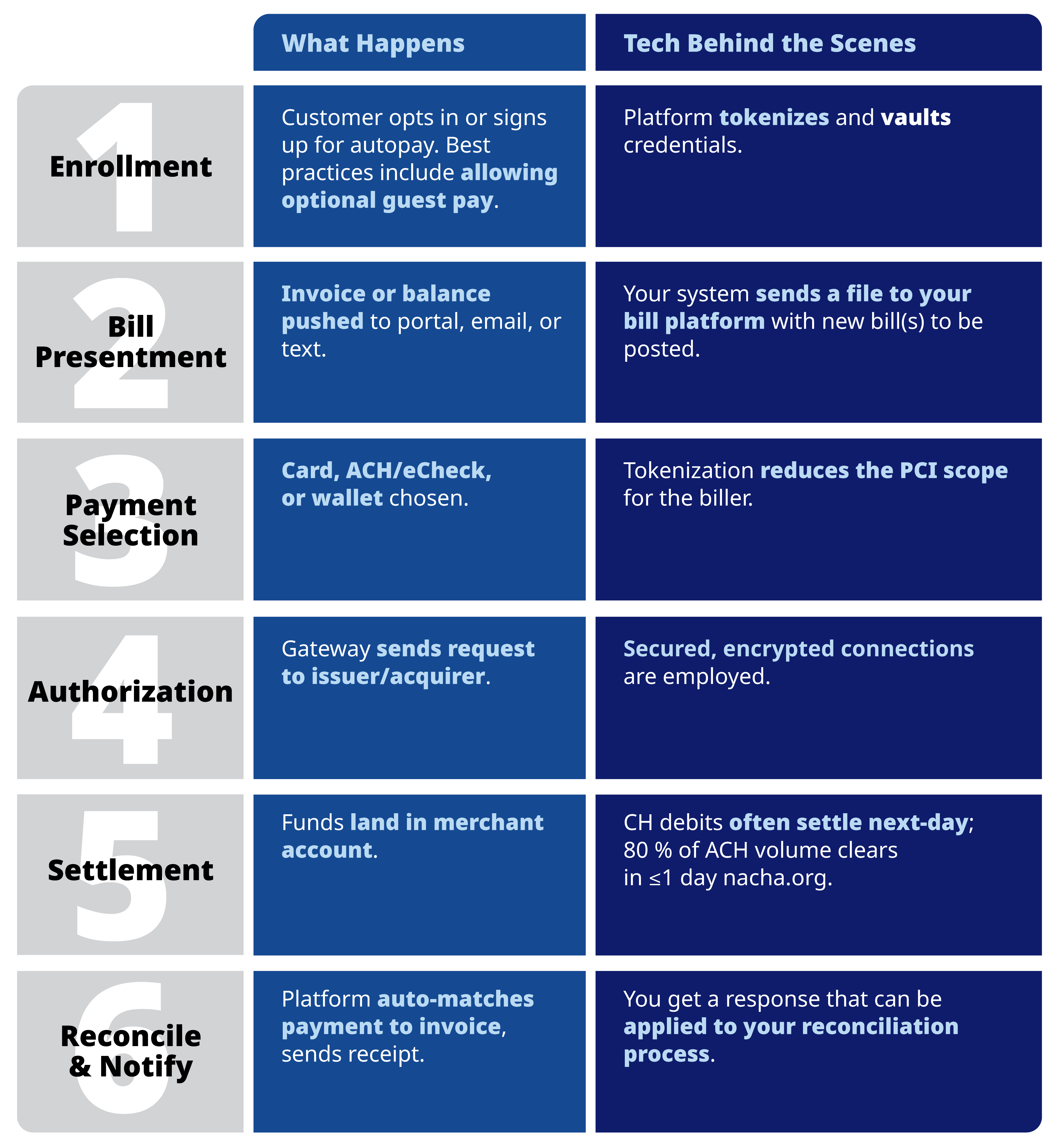It’s Time to Overhaul Your Government Payment System, But It’s Not as Taxing as You Think
Does your local or state government agency offer digital payments? If not, now is the time to follow the federal government’s lead. As of September 30, 2025, all federal disbursements and receipts are slated to be transitioned to digital disbursement, which means the end of paper checks for IRS refunds, Social Security payments and payroll disbursements. It also means where legally permissible, all payments to the federal government must be processed electronically starting October 1.
Why is Uncle Sam modernizing federal payments? According to the order, “The continued use of paper-based payments by the Federal Government … imposes unnecessary costs; delays; and risks of fraud, lost payments, theft, and inefficiencies. Mail theft complaints have increased substantially since the COVID-19 pandemic. Historically, Department of the Treasury checks are 16 times more likely to be reported lost or stolen, returned undeliverable, or altered than an electronic funds transfer (EFT).”
Digital payments have become the norm—92% of U.S. consumers used a website, app or digital wallet to make a payment in the past year. Despite the popularity of online payments, government agencies have been slow to adopt them. As of 2024, only 4.9% of local governments had implemented digital payments. When government agencies do accept online payments, they often rely on outdated, clunky payment systems that redirect users to third-party portals.
Modernizing your government payment system promotes operational efficiency, boosts convenience for payers and staff and increases collections. Flexible digital payment options make it easier for constituents to pay on time.
Outdated Payment Systems: Silent Saboteur of Timely Payments, Customer Trust and Back-Office Efficiency
Many government agencies still rely on checks, in-person cash payments or outdated systems, creating friction for payers and back-office staff.
The harder it is to pay a bill, the more likely people are to put it off. When the payment process takes too long, is difficult to navigate on a mobile device and/or requires too many resubmissions (due to system glitches), people may postpone paying their utilities, taxes, fees or other government bills. Millennials report they are more likely to prioritize paying bills that are easy to pay before taking care of those that are inconvenient.
Almost half (45%) of Americans have paid a bill late in the past year, according to a 2024 Lending Tree survey. Which bills were late? Utility bills (44%), cable/internet (34%) and rent/mortgage (31%) payments were most often paid late. Why? More than a quarter of the late payers (28%) mixed up the due date, and 28% forgot about the bill. Almost one third (32%) of consumers said that utilities are the most challenging type of bill to remember to pay on time (the most common response).
Clunky third-party payment portals damage customer experience and erode trust. When a portal is slow, glitchy or hard to navigate, payers may doubt the reliability of both the system and the government agency behind it. A jarring transition from your government website to the payment site—like completely different branding or layout—can seem unprofessional and raise concerns about legitimacy of the payment site. If the portal looks outdated, generates pop-ups or lacks clear security cues, users may even suspect phishing or data breaches.
Checks are costlier and labor intensive. “Checks probably have the highest labor cost associated with them,” Nacha reports. The cost of receiving paper checks ($1 – $2 per check) is higher than receiving Automated Clearing House (ACH or eCheck) payments ($.26 – $.50 per transaction). Back-office staff spend hours mailing paper bills and processing paper checks manually. It takes several steps to process paper checks, including:
- Sort the mail
- Match checks to accounts/invoices
- Endorse each check
- Complete a deposit slip
- Take the checks to the bank
Enter the payment information into the accounting or billing software
Billing staff must also field phone calls (to explain confusing bills) and chase late payments. All of these labor-intensive tasks claim valuable staff time that could be spent on more meaningful tasks that require a human touch.
The Solution: Offer Flexible Payment Options Residents Will Use
Flexible digital payment options are the key to improving payment efficiency, on-time collections and payer trust and satisfaction. Many consumers prefer to pay online. A 2024 Experian survey found that 58% of respondents pay bills online, while just 17% visit a location to pay a bill and a mere 15% mail their payments.
To satisfy diverse payer preferences, government agencies should offer a variety of flexible payment options, including:
Multiple payment methods. Government agencies should allow constituents to pay using their preferred payment method. Some of the most popular include:
- Credit/debit cards: According to the 2025 Diary of Consumer Payment Choice report, 88% of survey respondents used a credit card within 30 days of completing the survey; 74% had paid with a debit card.
- ACH: More than two thirds (70%) of survey respondents used this payment method. In addition to being less expensive than checks to process, ACH processing is faster. ACH payments can be settled within a few hours on the same business day, compared to paper checks that can take a week or longer to clear.
- Digital wallets: While consumers often reach for digital wallets to make online and—to a lesser extent—in-store purchases, they also use these convenient apps for bill payment. Recent PYMNTS research found that 40% of consumers had used a digital wallet to pay bills within the past year. Digital wallet payments are processed electronically (eliminating manual labor associated with paper checks), can be reconciled quickly, and typically clear within one to three days.
- Automatic payments (aka autopay or recurring payments): Automatic payments refer to automatically deducting payments from a specified bank account or credit/debit card on a scheduled basis. A PYMNTS survey of U.S. consumers found that 41% of consumers use automatic bill payments, with most (63%) using them for discretionary purchases. Fewer people (33%) use autopay for utilities like electricity, delinquencies, and time spent chasing late payments; and improved customer satisfaction.
- Partial payments: A partial payment option allows constituents to pay less than the full balance for utilities, taxes or other fees. People can make an initial payment and settle the remaining balance later. A payer who’s short on funds pays what they can to demonstrate good faith, stay in good standing and avoid late fees and service disconnection.
Modern Government Payment Processing Systems Benefit Payers and Governments
Government agencies need an electronic bill presentment and payment (EBPP) solution like CSG Forte BillPay to increase efficiency, on-time payments and payer satisfaction. EBPP lets you send invoices electronically and securely. Constituents can log in to the platform and pay using a credit/debit card, ACH transfer or digital wallet. To maximize these benefits, agencies should focus on implementing systems and features that streamline the payment process for both payers and staff, such as:
Offer seamless, unified payment experiences. Embedding the government payment processing system into your agency’s website and integrating it with your billing and accounting software can:
- Reduce friction and confusion
- Eliminate administrative errors
- Build payer trust
- Encourage on-time payments
Increase self-service capabilities. Customers can access and update their account information and make payments at their convenience—and connect with a human agent when they need more support.
Realize efficiency gains and cost savings. Automating the billing and payment processes and providing flexible payment options can:
- Save staff time: Your back-office staff won’t have to print and mail bills, process as many checks or manually reconcile payments. Clear billing statements and flexible payment options mean fewer billing-related phone calls.
- Reduce costs: Electronic invoices reduce printing and mailing expenses, and processing payments electronically saves money.
Go Digital: Do Less, Collect More with CSG Forte BillPay
Flexible digital payments are no longer a perk—they’re the expectation. Going digital leads to happier citizens, lighter staff workloads, and more on-time payments.
CSG Forte makes it easy to modernize your government payment system without starting from scratch. CSG Forte BillPay is an EBPP solution that lets you accept payments anytime, from any connected device, using flexible payment methods like credit/debit cards, ACH and digital wallets. It supports one-time, scheduled, recurring and partial payments and automatically sends custom reminders and confirmations.
BillPay delivers a transparent, mobile-friendly payment experience through a single-page checkout form that complies with all requirements for web and mobile accessibility. It plugs into your existing accounting software, so there’s no need to overhaul your current systems.
A leading utility service provider saw a 65% drop in failed payments after implementing BillPay’s recurring billing and Account Updater tool, which automatically keeps credit card data current. Intech Apex Court Solutions increased credit card collections by 230% by implementing Forte’s Text to Pay solution.
CSG Forte can help your government agency achieve similar results. See how:
- Read our eBook: 6 Ways a Digital-First Payment Solution Helps Provide Better Government Services
- Talk to an expert: Experience a Payments Platform Built for Government












